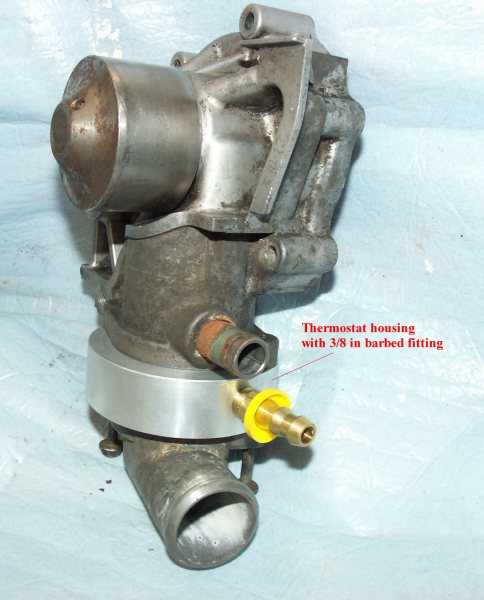
What were the Subaru cooling engineers smoking?
GeorgeL - June 10th, 2006 at 11:08 AM
OK, I've researched the Subaru cooling system to death. It's just about unanamous that the heater loop has to be connected for the thermostat to
work correctly. It is also common knowledge that this makes the cooling system somewhat tricky to work with.
My question is: Why did they do it that way? Just about every engine out there has a thermostat located in the coolant outlet _after_ the
heat-producing parts of the engine, and that even includes the VW aircooled engines! Subaru does it backwards, piping a little hot water back to the
heat _inlet_ to open the thermostat.
Possible ideas:
1. Subaru didn't want the thermostat to open until the heater core was fully supplied with hot water?
2. Subaru wanted the engine to run warmer in cold weather when the heater was in use (due to the heater core lowering the temperature of the coolant
before it gets to the thermostat)?
3. Subaru's thermostat location was engineered by an 8-year-old who was visiting during "take your child to work day"?
Anyway, if one wants "normal" cooling system operation all that must be done is remove the stock thermostat and add an in-line thermostat just after
the coolent outlet. It would be a good idea to put a little bleed hole in the thermostat to allow a bit of flow. This would eliminate the need for
the heater loop and simplify plumbing.
George
mackaymanx - June 10th, 2006 at 12:07 PM
There is a fix the vanagon guys use in the US for the colder climate when they use the heater alot
http://www.subaruvanagon.com/tom/Cooling%20System.htm

[ Edited on 10-6-2006 by mackaymanx ]
GeorgeL - June 11th, 2006 at 05:11 AM
That's an interesting item that I've not seen before. Apparently, the new part moves the thermostat a couple of centimeters away from the heater
return flow and supplies a warmer coolant flow straight from the engine coolant outlet to operate the thermostat.
It still seems like a rather silly arrangement to me. Why put the thermostat at the inlet and then kludge an outlet-to-inlet bypass to provide a
temperature signal for the themostat?
How is this handled in the stock Subaru? Does all the heater bypass coolant flow through the Subaru heater core? If so, why doesn't the stock
Subaru overheat due to the heater dropping the temperature of the bypass coolant too much?
The Subaru engineers are obviously not stupid, but I am just not understanding their logic in the thermostat arrangment. The worst thing you can have
is a thermostat that fails to open, and the Subaru arrangement makes this much more likely. A number of people have come to grief over this. Since
the radiator part of my cooling system will already be a fairly"brute force" approach, I'm tempted to go to an in-line thermostat at the engine
coolant outlet to eliminate the possibility of bypass-related problems. I will have enough fun getting the thing to run without worrying about the
cooling system screwing things up.
George
mackaymanx - June 11th, 2006 at 09:18 AM
I think you have to look at the volume of the heater circuit in a subaru compared to non stock applications.The subaru heater is very close to the
motor reducing the volume of the circuit.Of course the stock heater is designed to match the motor but I dont know what the secret is.
GeorgeL - June 12th, 2006 at 06:38 AM
| Quote: |
Originally
posted by mackaymanx
I think you have to look at the volume of the heater circuit in a subaru compared to non stock applications.The subaru heater is very close to the
motor reducing the volume of the circuit.Of course the stock heater is designed to match the motor but I dont know what the secret is.
|
That's a good point. It's a pretty good bet that the heating capacity (and therefore the cooling effect on the coolant) of the stock Subaru heater
was quite a bit less than the capacity of a typical Vanagon system, particularly the ones with front and rear heating cores. It may be that the
heater bypass flow rate through the Subaru heater was rapid enough to produce a small temperature drop across the core, even with cold air being
passed through the core to heat the cabin.
Another thought that I have had about the placement of the thermostat is that putting it at the inlet reduces the pressure variations in the engine
block over placing the thermostat at the outlet. Might be better for keeping the head gaskets sealing.
I know that Subarus have had touchy head gasket issues for a very long time. I had a wet sleeve EA71 engine that I could never get to seal right no
matter how carefully I matched the gaskets and seals (they came in various thicknesses to compensate for various sleeve/head clearances). It always
had oil in the water and water in the oil, but still ran like a champ throughout. I don't want to repeat this experience on an EJ25, though.
George


